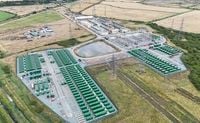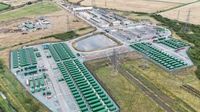On August 18, 2025, the United Kingdom marked a significant milestone in its clean energy journey as the country's largest battery energy storage system (BESS) was officially powered up in Thurrock, Essex. Developed by Statera Energy and connected to the grid by National Grid Electricity Transmission (NGET), the Thurrock Storage project is now delivering flexible, low-carbon electricity to London and the southeast, signaling a bold step in the nation's transition away from fossil fuels.
The Thurrock Storage facility boasts an impressive 300 megawatts (MW) of power and a total energy capacity of 600 megawatt-hours (MWh). According to Statera Energy, this landmark battery site is capable of powering up to 680,000 homes with instantaneous power for two hours, providing a robust buffer to the grid during periods of fluctuating renewable generation. Located immediately north of the former Tilbury coal power station, the site’s transformation from coal to cutting-edge battery technology stands as a powerful symbol of the UK’s evolving energy landscape.
The energisation of Thurrock Storage was hailed by both its developers and the grid operators as a crucial achievement. Tom Vernon, CEO and founder of Statera Energy, expressed his excitement at the milestone: “We are delighted that Thurrock Storage is now energised, following its connection to the grid by National Grid Electricity Transmission. Increasing BESS capacity is essential for supporting the grid when renewable generation, such as solar and wind, is low or changes quickly. It ensures that energy can be stored efficiently and returned to the grid whenever it’s needed.”
The technical prowess of the Thurrock Storage system is notable. The battery can respond within seconds to changes in grid demand, delivering its full output of up to 600 MWh almost instantaneously. This rapid response capability is particularly valuable as the UK continues to integrate higher shares of renewable energy, which can be unpredictable due to weather variability. By absorbing surplus low-carbon electricity and releasing it when demand spikes, the Thurrock site enhances grid stability and helps defer more costly investments in network capacity upgrades.
National Grid, which undertook reinforcement work at the Tilbury substation to accommodate the new installation, emphasized the broader significance of the project. John Twomey, Director of Customer and Network Development at NGET, remarked, “Battery storage plays a vital role in Britain’s clean energy transition. Connecting Thurrock Storage, the UK’s biggest battery, to our transmission network marks a significant step on that journey. Our Tilbury substation once served a coal plant, and with battery connections like this, it’s today helping to power a more sustainable future for the region and the country.”
The location of the Thurrock Storage project is strategic in more ways than one. Situated close to London, it directly supports the capital and the densely populated southeast—a region that represents a major demand center for electricity. The battery sits alongside the Thurrock Flexible Generation plant, a 450 MW facility also developed by Statera Energy, which is designed to provide additional backup during extended shortfalls in renewable output. National Grid confirmed that work is ongoing to connect this flexible generation facility, further strengthening the region’s energy resilience.
The transformation of the Tilbury site is particularly poignant. Once home to the now-demolished Tilbury A and B coal-fired power stations, the area is being repurposed to underpin the UK’s clean energy ambitions. Industry figures have described the new battery connection as a tangible example of the country’s shift from fossil fuels to cleaner forms of electricity generation. As the UK works towards its net-zero targets, projects like Thurrock Storage are expected to become increasingly central to the national grid’s operations.
Statera Energy’s ambitions extend well beyond Thurrock. The company already has over 2.1 gigawatts (GW) of projects delivered or under construction in the UK, with more than 16 GW in development or consented. Backed by £1 billion of committed investment to date and plans to invest up to £7 billion by 2030, Statera is positioning itself as a major player in the UK’s low-carbon transition. The company also highlighted that the Thurrock project will generate local career opportunities and apprenticeships in operations and maintenance, supporting sustainable employment in the Essex region.
The importance of large-scale battery storage systems is increasingly recognized across the UK’s energy sector. As reported by New Civil Engineer, battery energy storage systems like Thurrock’s are now central to balancing an electricity system that relies more heavily on intermittent sources such as wind and solar. These batteries can deliver vital frequency-response services, help manage grid volatility, and provide a more cost-effective alternative to traditional peaking plants.
However, the rapid growth of big BESS projects is not without its challenges. Some analysts and critics note that the economics of these installations depend on market signals for price volatility and grid services. Additionally, the need for longer-duration storage solutions remains a policy and commercial challenge as renewable penetration increases. Nevertheless, the consensus within the industry is that batteries like those at Thurrock are indispensable for the UK’s clean energy future.
The energisation of Thurrock Storage comes on the heels of other major renewable energy milestones in the UK. In July 2025, the 373 MW Cleve Hill Solar Park in Kent—currently the country’s largest solar installation—was connected to the grid, further underscoring the nation’s momentum in renewable deployment. As more large-scale storage and renewable projects come online, the UK’s grid is expected to become increasingly flexible, resilient, and sustainable.
For the residents of Essex and the broader southeast, the Thurrock Storage project represents more than just a technical achievement. It’s a promise of cleaner air, new job opportunities, and a more reliable electricity supply. For policymakers and industry leaders, it’s a blueprint for how legacy energy infrastructure can be repurposed to meet the demands of a decarbonized future.
With the UK’s largest battery now operational and further investments on the horizon, the nation is making tangible progress toward its net-zero ambitions—one megawatt at a time.

